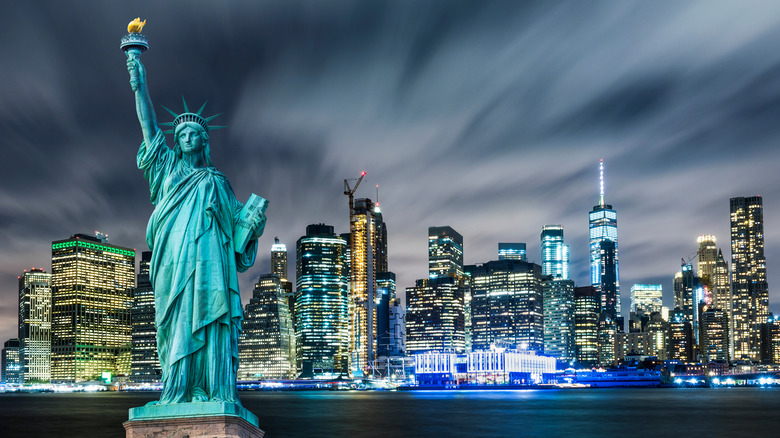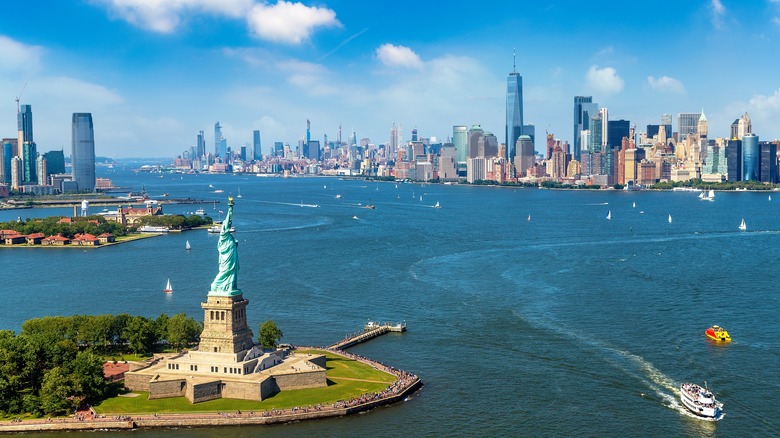This Is How Much The Europeans Paid For Manhattan
New York City is famous around the world as a bustling metropolis and a cultural hub. It's home to some of the planet's most iconic sights, from the Empire State Building to the Statue of Liberty, and boasts an awe-inspiring range of restaurants, museums, theaters, and stores.
The great cachet of New York City, of course, is reflected in its wealth (as well as its dizzying cost of living). Henley & Partners declares the Big Apple the planet's richest city, and the glitzy borough of Manhattan is central to this. According to the Zumper National Rent Report in October of 2022, the median rent of a one-bedroom apartment in New York City is the nation's most expensive, at $3,860.
The borough of Manhattan, Britannica reports, is primarily located on the island that bears its name, though there are also small areas of the mainland that are designated as part of it. Manhattan was, Smithsonian Magazine adds, originally the name of a settlement that the Lenape called home. Manhattan Island, as it was known by residents, changed forever when settlers from Europe arrived.
When European settlers purchased Manhattan, they paid a curious sum indeed. Here are the details on the deal that was agreed upon.
60 Dutch guilders was the reported price
Per Smithsonian Magazine, the Lenape indigenous people lived in an area they called Lenapehoking, part of which would later become known as Manhattan. The Lenape lands stretched into Delaware. Settlers from the Netherlands reportedly bought the island from the Lenape in 1626.
Per Britannica, it was New Netherland director general Peter Minuit who brokered the transaction. The price was believed to have been about 0.7 kilograms (1.5 pounds) of silver, in the form of 60 guilders. The famous story remains in doubt, however.
Per Live Science, trade was central to the beginnings of the relationship between the Dutch settlers and the Lenape. The region was also home to many, many beavers, the pelts of which the settlers were desperate to get their hands on for the manufacture of hats. The Lenape were, reportedly, happy to provide them, in exchange for materials such as metals. This proved incredibly profitable for the Dutch, who (with other European settlers hot on their heels) had their eyes on an even greater prize: the future Manhattan Island itself.
According to Live Science, the 60 guilders (Dutch currency) price discussed by Britannica conflicts with the much-ballyhooed belief that Manhattan was bought for a meager $24 worth of small items such as beads. 60 guilders, The Gotham Center For New York City History wrote in 2012, would have amounted to approximately $1,000 at the time of their report.
New York, New York
This price entered the historical record through the letter of one Peter Schagen, representative of the States General in the Assembly of the Nineteen of the West India Company. In 1626, Schagen wrote (via a translation from the New Netherland Institute), "they have purchased the Island Manhattes ... for the value of 60 guilders. It is 11,000 morgens in size [22,000 acres approximately]."
As Live Science reports, though, this remains questionable evidence. Schagen was not present when the deal was made, and it's now all but impossible to say whether the deal meant what it was taken to mean. As the Wildlife Conservation Society's Eric Sanderson told the outlet, "the Dutch came with a certain idea about property that was not the idea of the Indigenous people." Perhaps access to the land was what was intended to be for sale, or passage through it.
Around the middle of the century, a wall was built around what became known as New Amsterdam, per Smithsonian Magazine. The Lenape, the Lenape Center's Curtis Zunigha reportedly told the outlet, were forced to leave for Pennsylvania, embarking on a painstaking odyssey that would ultimately lead them to an Oklahoma reservation of the Cherokee, which they bought and made their home.
Britannica adds that New Amsterdam and Manhattan came under British control in 1664, when it was renamed New York. It was named, World Atlas reports, for James II of England and Scotland, who had been Duke of York.


